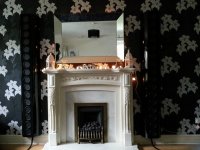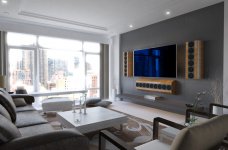I've heard the original Linus, built and set up by Rick Craig, and my impression was the same. Ditto for the bigger Magnepans, and the Pipedreams. I can see how some people would enjoy that sound, but I'm not one of them.
The only real question, IMO, is whether that's innate to the speakers, or "listening with your eyes," i.e. seeing a big tall array and the mind filling in for the ears what the mind thinks the ears were supposed to have heard.
My impression of perceived height from Quad ESL-63s, big concentric drivers, the Snell XA, even the mega-headphones Dunlavy used to sell, also mirror what you wrote.
The only real question, IMO, is whether that's innate to the speakers, or "listening with your eyes," i.e. seeing a big tall array and the mind filling in for the ears what the mind thinks the ears were supposed to have heard.
My impression of perceived height from Quad ESL-63s, big concentric drivers, the Snell XA, even the mega-headphones Dunlavy used to sell, also mirror what you wrote.
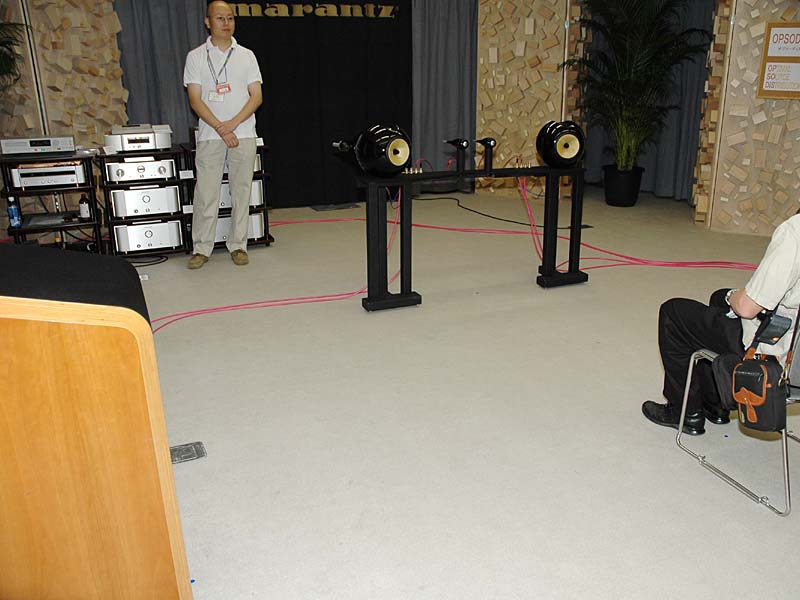
I think that's the magic behind Opsodis.
An externally hosted image should be here but it was not working when we last tested it.
It basically takes the foundation of the Quads, the big Dynaudios, the Vandersteens and the Snells, and it flips it on it's side.
If one was truly crazy, it seems like it would be possible to do this in both the X *and* the Y axis. IE, an array that's both horizontal and vertical.
I have also heard line arrays that made instruments sound unnaturally huge, but that was from finite line arrays with all those limitations and poor vertical polar plots showed by Keele in his CBT papers.
Patrick Bateman and Pallas, it seems like it's those speakers you are discussing too.
My goal is to build a virtual infinite line array with a true cylindric wavefront in the whole room. My understanding is that then you will only hear the sound sources that are at ear height. Then you will not have the problem of different arrival times.
Comb filtering can be avoided by using some true line source elements like those from BG.
Patrick Bateman and Pallas, it seems like it's those speakers you are discussing too.
My goal is to build a virtual infinite line array with a true cylindric wavefront in the whole room. My understanding is that then you will only hear the sound sources that are at ear height. Then you will not have the problem of different arrival times.
Comb filtering can be avoided by using some true line source elements like those from BG.
There are several ways to configure a line but, it appears a floor to ceiling cfg is fine unshaded and not delayed. Mid height cfg's need the CBT concept, or artificial delay, amplitude and/or frequency dependent shading or the expanding array architecture to correct for the so-called problems. If these philosophies are not implemented, in lue of a simple strait array, this seems to be setting the president for "Line Array's" in general and spreading a bad reputation even further.
I must say, I am disappointed at the available data and experimental results for frequency shading of strait lines??? But there is no doubt these other aspects I mentioned improve the problems of strait arrays that are not mostly floor to ceiling 😀
As usual, different strokes...YMMV... etc...
I must say, I am disappointed at the available data and experimental results for frequency shading of strait lines??? But there is no doubt these other aspects I mentioned improve the problems of strait arrays that are not mostly floor to ceiling 😀
As usual, different strokes...YMMV... etc...
Last edited:
Patrick, in the first picture you have, the small speakers on stands, imo they are set up incorrectly. Too close, the listener is way too far back for this spacing. You get basically a small slightly better than mono result. So, put your orchestra or grand piano in that space, what do you end up with? Is that natural? Perhaps that is what a grand piano sounds like at a distance of 75 feet or so, etc... of course if you make it loud, in this set up it comes forward, but the size is still basically wrong from that listening position.
I'd vote for a wider, like double the distance between speakers, and the speakers higher off the floor, unless you prefer to sit above the performers?
The finite length line arrays (un-tapered) only have problems IF you sit far enough back WRT to the array where your head starts to get close to the height that is close to the top of the arrray. Assuming the array reaches the floor! Shorter arrays that neither reach high enough or go low enough have assorted issues including the ones just mentioned, plus things like floor bounce (as does a standard speaker), etc...
Three ears does make for a solid center image! 😀
I'd vote for a wider, like double the distance between speakers, and the speakers higher off the floor, unless you prefer to sit above the performers?
The finite length line arrays (un-tapered) only have problems IF you sit far enough back WRT to the array where your head starts to get close to the height that is close to the top of the arrray. Assuming the array reaches the floor! Shorter arrays that neither reach high enough or go low enough have assorted issues including the ones just mentioned, plus things like floor bounce (as does a standard speaker), etc...
Three ears does make for a solid center image! 😀
Bear explained very well his insight on what Patrick likely heard from finite length line arrays versus true floor to ceiling arrays. A true floor to ceiling line array (or a near field array) will not demonstrate an over sized sound.
In my “Design Guidelines for Practical Near Field Line Arrays” white paper (I’ll call it NFLAWP for short) I describe criteria for builders to build practical near field line arrays. A floor to ceiling line array will essentially place listeners within the room in the near field. In the near field the radiated sound forms a coherent wave front that extend from top to bottom of the array. You can see the vertical axis polar radiation patterns for both the near (5 meters distance in this example) and far (50 meters) fields in Figure 2 in the NFLAWP. Notice that the near field energy flows away from the array with minimal spreading upper ward or down ward in the vertical plane.
Now can you hear this pattern in the listening room as you listen to a near field line array?
You can duplicate these observations and the nature of near field radiation by listening in front of the array (say 4-6 feet on axis away so that minimal room effects disturb your hearing of the direct sound). Now kneel or squat while you listen and slowly move to a standing position. When you do this what you hear is that the sound is at a constant volume and at ear level as you move upward (or back down). You do not hear sound from the top of the array nor the bottom of the array when you do this but the sound follows along as you move up or down. Essentially, your ear/brain processes by the precedence effect so that you hear a slice of the radiation pattern as you move.
Bottom line no over sized sound from a proper near field array.
http://www.audioroundtable.com/misc/nflawp.pdf
In my “Design Guidelines for Practical Near Field Line Arrays” white paper (I’ll call it NFLAWP for short) I describe criteria for builders to build practical near field line arrays. A floor to ceiling line array will essentially place listeners within the room in the near field. In the near field the radiated sound forms a coherent wave front that extend from top to bottom of the array. You can see the vertical axis polar radiation patterns for both the near (5 meters distance in this example) and far (50 meters) fields in Figure 2 in the NFLAWP. Notice that the near field energy flows away from the array with minimal spreading upper ward or down ward in the vertical plane.
Now can you hear this pattern in the listening room as you listen to a near field line array?
You can duplicate these observations and the nature of near field radiation by listening in front of the array (say 4-6 feet on axis away so that minimal room effects disturb your hearing of the direct sound). Now kneel or squat while you listen and slowly move to a standing position. When you do this what you hear is that the sound is at a constant volume and at ear level as you move upward (or back down). You do not hear sound from the top of the array nor the bottom of the array when you do this but the sound follows along as you move up or down. Essentially, your ear/brain processes by the precedence effect so that you hear a slice of the radiation pattern as you move.
Bottom line no over sized sound from a proper near field array.
http://www.audioroundtable.com/misc/nflawp.pdf
Last edited:
Thank you Jim 😀... A true floor to ceiling line array (or a near field array) will not demonstrate an over sized sound.... A floor to ceiling line array will essentially place listeners within the room in the near field. In the near field the radiated sound forms a coherent wave front that extend from top to bottom of the array....You do not hear sound from the top of the array nor the bottom of the array when you do this but the sound follows along as you move up or down. Essentially, your ear/brain processes by the precedence effect so that you hear a slice of the radiation pattern as you move... Bottom line no over sized sound from a proper near field array....
Thank you Patrick 😀
Thank you Bear 😀
Patrick, in the first picture you have, the small speakers on stands, imo they are set up incorrectly. Too close, the listener is way too far back for this spacing. You get basically a small slightly better than mono result. So, put your orchestra or grand piano in that space, what do you end up with? Is that natural? Perhaps that is what a grand piano sounds like at a distance of 75 feet or so, etc... of course if you make it loud, in this set up it comes forward, but the size is still basically wrong from that listening position.
You did notice the low frequency woofers on the side of the listening position?
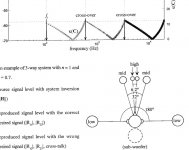
(A picture to make it clear)
No idea if this works, never had the opportunity to listen to this kind of setup.
But my gut feeling would say the same as you just said 🙂. If you see the setup in the above picture it makes it more clear what Patrick said about those Dynaudio's on its side (and bent over backwards).
Last edited:
I think that's the magic behind Opsodis.
Opsodis seems to be a crosstalk cancellation approach and is probably more than the speaker configuration suggests.
http://www.southampton.ac.uk/images/fee/OPSODIS.ppt
Oh! - if those little speakers in Patrick's first image use signal processing to create "wider than normal" sound imaging, skip my comments - but doing this trick is another discussion, albeit a very interesting one. I'm not sure what those speakers are, so guess I'll now have to read up... I don't get the audio rags, so I am not up on the latest stuff by any means, like years worth of products. Not good in some ways, like now for example.
Shooting from the hip, with no real info... wesayso, I'd say one would do best with this set up using a dentists chair/head-clamp arrangement - but perhaps it is more forgiving than that.
Shooting from the hip, with no real info... wesayso, I'd say one would do best with this set up using a dentists chair/head-clamp arrangement - but perhaps it is more forgiving than that.

Last edited:
For me, it's fairly simple: I'd build a floor-to-ceiling line array right now if I had the money to buy some 50 pieces of hi-quality 3" fullrange speakers (alpair or similar). Now calculate how much could that cost. As it is, it could happen only if I win a lottery and don't tell my wife about it 😀
How about 32 4.5 inch full rangers...?
I don't know how much your lottery win price is but if you can find a USA supplier I recommend the 4.5 inch Neo magnet BMR.
There are a few versions from different OEM manufacturers.
I hope to be ready to start a DIY kit of 32 drivers in the UK in a couple of months, price around £1,250 for the drivers.
Even the 6 or 9 drivers per speaker gives really fab results, with Sd of 67.5 a 9 driver line array has a greater surface area than a 12 inch driver...
I have attached a pic of the finished speakers.
Cheers
Derek.
I don't know how much your lottery win price is but if you can find a USA supplier I recommend the 4.5 inch Neo magnet BMR.
There are a few versions from different OEM manufacturers.
I hope to be ready to start a DIY kit of 32 drivers in the UK in a couple of months, price around £1,250 for the drivers.
Even the 6 or 9 drivers per speaker gives really fab results, with Sd of 67.5 a 9 driver line array has a greater surface area than a 12 inch driver...
I have attached a pic of the finished speakers.
Cheers
Derek.
For me, it's fairly simple: I'd build a floor-to-ceiling line array right now if I had the money to buy some 50 pieces of hi-quality 3" fullrange speakers (alpair or similar). Now calculate how much could that cost. As it is, it could happen only if I win a lottery and don't tell my wife about it 😀
Attachments
Wesayso - where did that picture of the strange array come from? Google Books?
That looks like it would be fun to try at the shop, we have plenty of speakers and processing there. I'd like to read more about it and give it a try. Thanks.
EDIT: Found it. It's called OPSODIS
That looks like it would be fun to try at the shop, we have plenty of speakers and processing there. I'd like to read more about it and give it a try. Thanks.
EDIT: Found it. It's called OPSODIS
Hi Pano, do you mean this one?
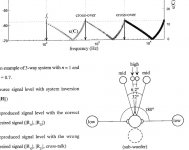
You'll have to ask Patrick (John) for that ;-)
Crazy Imaging in a Stock System - Car Audio | DiyMobileAudio.com | Car Stereo Forum
Source seems to be the Philips OPSODIS paper, haven't seen/read it in total yet.
I remembered the reference from the diymobileaudio forums as I am a member there also.

You'll have to ask Patrick (John) for that ;-)
Crazy Imaging in a Stock System - Car Audio | DiyMobileAudio.com | Car Stereo Forum
Source seems to be the Philips OPSODIS paper, haven't seen/read it in total yet.
I remembered the reference from the diymobileaudio forums as I am a member there also.
Last edited:
Thanks I see Patrick is all about it. 🙂
I can't find the paper that image came from, nor the whole page - just a PowerPoint presentation. Mainly wondering about phase.
But this is OT - sorry.
I can't find the paper that image came from, nor the whole page - just a PowerPoint presentation. Mainly wondering about phase.
But this is OT - sorry.
The paper seems to have disappeared. It used to be on the Phillips website, but no more.
It's actually on topic, as an Opsodis array isn't much different than a conventional multiway array... On its side!
Subjectively, I find pluses and minuses:
The good:
1) An image that's much much wider than you get with a stereo triangle, yet theres no "hole" in the center. It's remarkable that having tweeters five feet from your midbasses works, but hearing is believing.
2) it looks good. With the midbasses so far away, the setup looks clean and modern.
The bad:
1) intelligibility isn't as good as it is with a conventional two way. This is particularly noticeable with movies and podcasts. Low level detail, which my vandersteens and synergy horns excel at, is obscured.
It's actually on topic, as an Opsodis array isn't much different than a conventional multiway array... On its side!
Subjectively, I find pluses and minuses:
The good:
1) An image that's much much wider than you get with a stereo triangle, yet theres no "hole" in the center. It's remarkable that having tweeters five feet from your midbasses works, but hearing is believing.
2) it looks good. With the midbasses so far away, the setup looks clean and modern.
The bad:
1) intelligibility isn't as good as it is with a conventional two way. This is particularly noticeable with movies and podcasts. Low level detail, which my vandersteens and synergy horns excel at, is obscured.
This stuff is interesting, but this is a thread about line arrays. Maybe someone could start a new thread?
I looked at Jim Griffin''s paper for guidance about the time/distance misalignment problem*. The "solution" appears tucked quietly in a table. Like the sign said about smoking, "You either have to stop smoking or go elsewhere" - you can live with it or you have to trim the sound towards the middle drivers like a Quad 63 thereby vetoing the line-array advantages.
This old good thread seems to be comparatively shy on REW freq curves. Hmm.
There are many different aspects to good sound reproduction and each type of system however unique can be strikingly nice in some sub-set of these aspects. ESL folks love the amazing clarity and live with other shortcomings. Line-array people likewise take delight in some aspects, I suppose, and live with some shortcomings. I used to have a 12-inch driver hanging by a rope in my workshop and greatly loved the sound for what it was. As G.A. Briggs (Whardale) said, even better covered in sawdust.
Ben
*which I am pondering apropos measuring curved electrostatic arrays which necessarily have distance misalignment and so doing violence to the treble measurements by cancellation, in another thread.
This old good thread seems to be comparatively shy on REW freq curves. Hmm.
There are many different aspects to good sound reproduction and each type of system however unique can be strikingly nice in some sub-set of these aspects. ESL folks love the amazing clarity and live with other shortcomings. Line-array people likewise take delight in some aspects, I suppose, and live with some shortcomings. I used to have a 12-inch driver hanging by a rope in my workshop and greatly loved the sound for what it was. As G.A. Briggs (Whardale) said, even better covered in sawdust.
Ben
*which I am pondering apropos measuring curved electrostatic arrays which necessarily have distance misalignment and so doing violence to the treble measurements by cancellation, in another thread.
Last edited:
- Status
- Not open for further replies.
- Home
- Loudspeakers
- Multi-Way
- Floor-to-ceiling array vs CBT
